
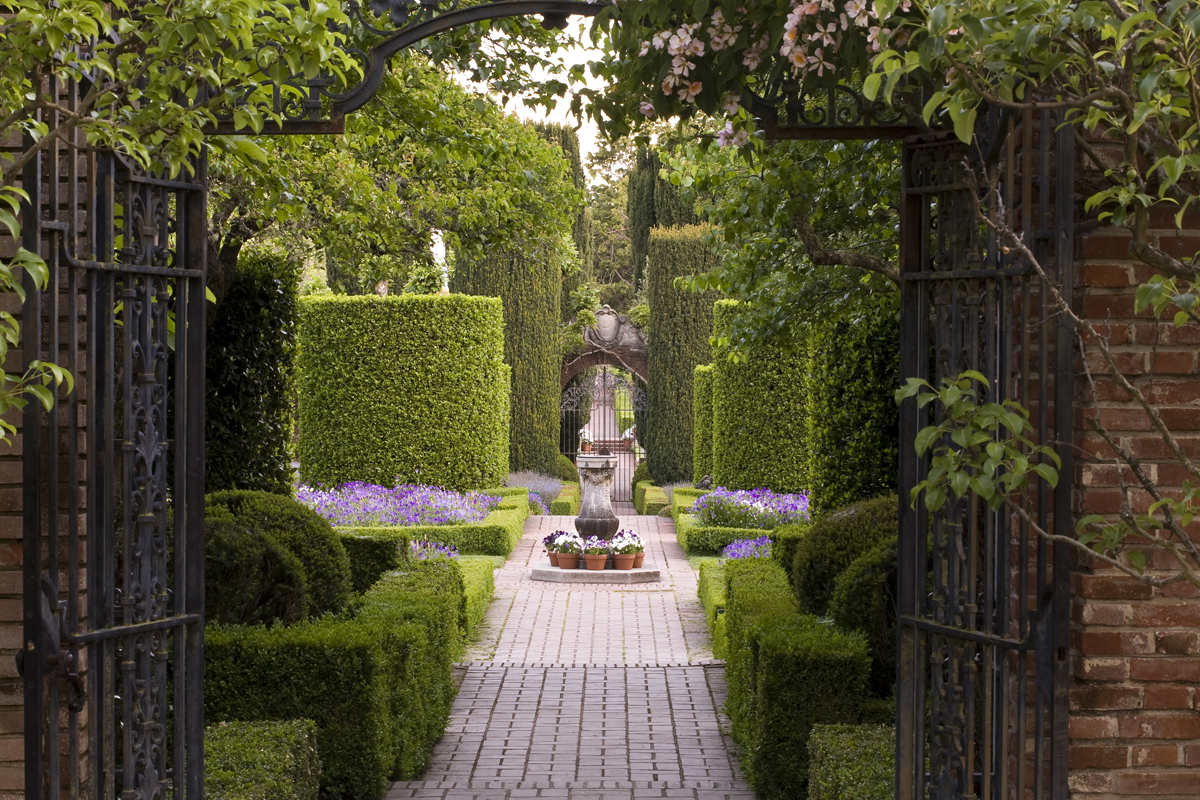
Contributor
- Topics: Archive, Inspired Gardens and Design
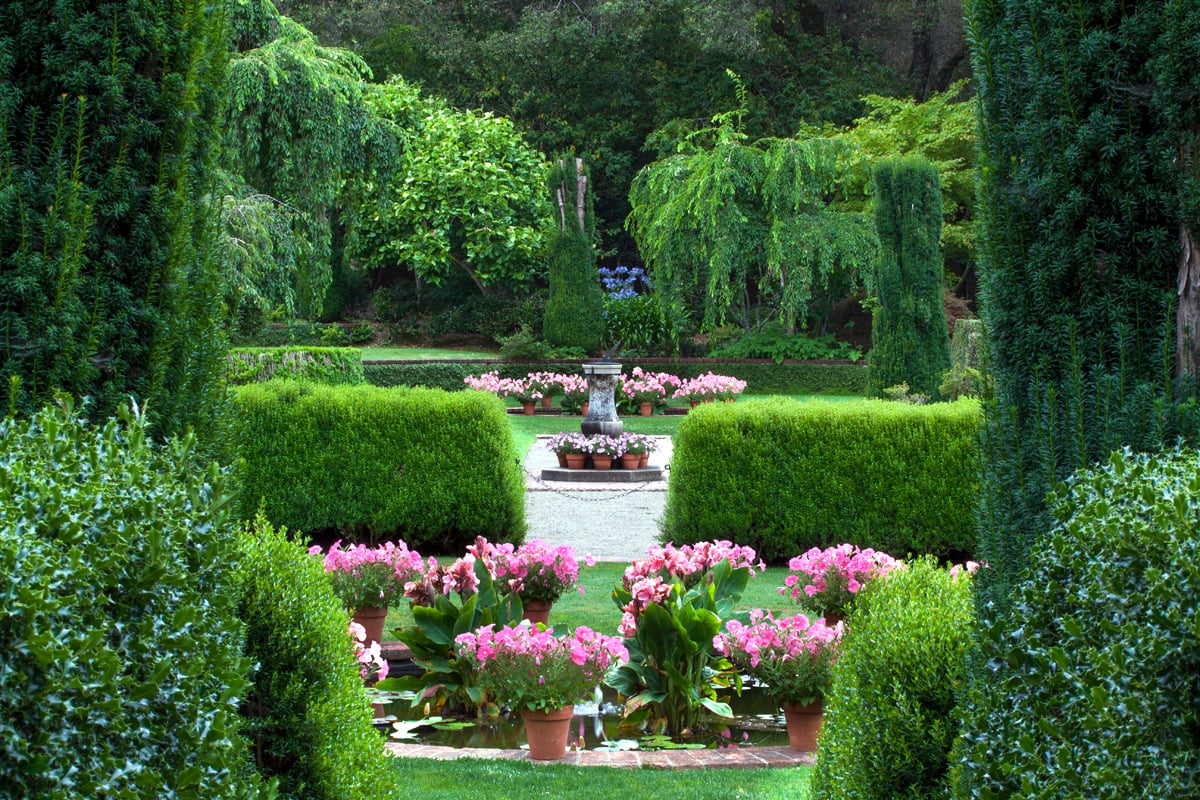
Lucy Tolmach spent 35 years working at Filoli, first as a gardener starting in 1977 before being promoted to Garden Superintendent in 1979. Her title changed to Director of Horticulture in 1997. Filoli is known as one of the most exquisite gardens in California and a fine example of a Country Place-era estate, a period of affluent American landscape design. Lucy now lives with her husband Jonathan in a 1938-era cabin on an oak knoll in the Ojai Valley where they grow fruits, vegetables, and cut flowers.
Molly Barker worked at Filoli for 16 years. She then became Director at Casa del Herrero, a National Historic Landmark in Santa Barbara with Moorish gardens. She is now Director at the Mendocino Coast Botanical Gardens in Fort Bragg, enjoying a very different garden and her new home.

The following conversation between Lucy Tolmach and Molly Barker took place in early winter 2019 at the dining room table in the cabin upon the oak knoll:
Molly: It’s kind of funny recording our conversation ‘cause we’ve known each other for almost 30 years now, you know?
Lucy: Well, I know it’s been a long time.
Molly: So how did you get into horticulture? Or have you always been a gardener?
Lucy: When I was a kid I always used to grow things, when I was less than eight years old I had a garden in New London, Connecticut. It was just odd things—like I planted sprouted onions from the pantry. I remember when we moved that an onion I had planted was blooming in our garden. The family that bought our house had a young girl about my age. I introduced her to the onion plant and told her she had to take care of it.
The gardener in the family was my mother. We had a big bed of peonies.
Molly: That’s enough to make you become a gardener right there.
Lucy: But I certainly didn’t know the term horticulturist. On the bus in high school, we were discussing what to do after graduation. I didn’t know for sure and a friend asked if I had thought of horticulture. I went to the University of Delaware and received a Bachelors degree in Plant Science. I think I was influenced to move to that area because I loved Longwood Gardens. My parents took me there when I was 14 and I fell in love with it. Then I went out West to earn my Masters in Environmental Horticulture at [UC] Davis.
I started as a gardener at Filoli in 1977.
The National Trust For Historic Preservation (NTHP) required scaled drawings of the Filoli garden for documentation and there were no original drawings that we knew of. For the first six months, my job was to measure and draw the gardens so that there’d be documentation of the basic layout. I worked on the pastry table in the main kitchen of the house with my T-squares and triangles.
Later we used those drawings to design the irrigation system and for determining the square footage for plantings, fertilizer, and other uses.
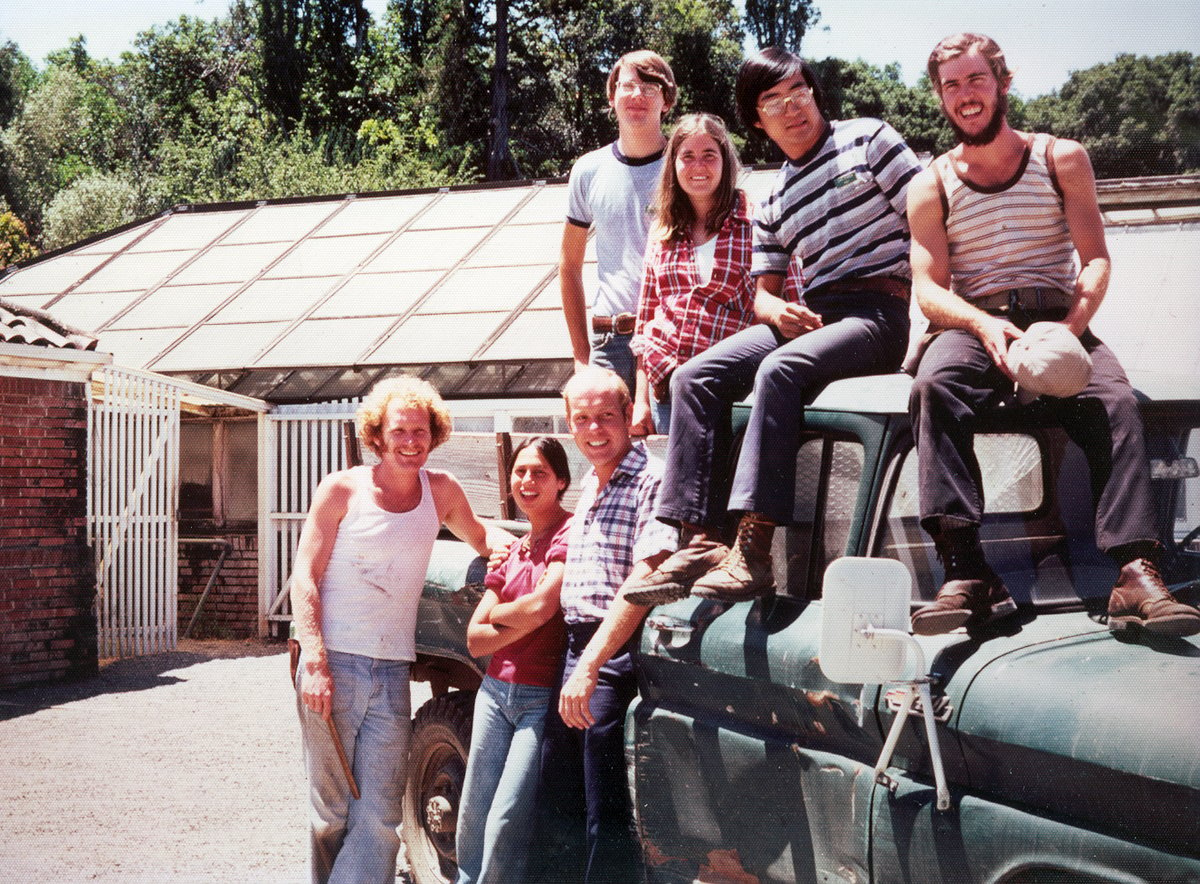
Jonathan enters with sandwiches on homemade bread
Molly: That’s a huge sandwich!
Lucy: Really good.
Molly: Back to Filoli. A number of people helped to transition Filoli from a private estate to a publically accessible Historic Landscape.
Lucy: Mai Arbegast was very much responsible. Lurline Roth, the owner of Filoli, had a buyer that assured her that the property would not be sold, divided, developed, or any of those things—that the garden and its magnificent backdrop would be preserved. But it came to light that a planning company had been hired to subdivide and sell off part of the land. At that point, Mai Arbegast moved in. She was a prominent professor in the Department of Landscape Architecture at U.C. Berkeley and designer of many estate gardens in the San Francisco Bay area. She was a very strong woman with a lot of clout and knowledge.
Mai persuaded Lurline Roth to consider working with the NTHP to preserve Filoli and she eventually deeded the historic corridor of the property to the NTHP along with a 2.3 million dollar endowment.
Molly: There were also friends of Mrs. Roth’s that helped with Filoli’s transition—like Sally McBride?
Lucy: Certainly—Sally McBride was the first President of the Friends of Filoli. Also, Willa Budge and Ann Westerfield were real plantswomen who were also influential within the community.
Molly: Not to mention their involvement in the Garden Club of America. A lot of people, including professional gardeners, don’t realize the importance of that organization. I say, “Do not underestimate the power of The Garden Club of America.” It’s not just a garden club dedicated to flowers and such. They’ve always been involved with garden conservation documentation and more.
Lucy: All those women were on the original founding board of Filoli. Also, Mildred Mathias, who was down at UCLA, was on the advisory committee. She was just such an amazing person.
Molly: She had an edge to her when I met her.
Lucy: She had an edge to her. She did. She’d go to Mexico collecting salvias and would camp out with everyone. She showed our staff how to burn the glochids off cactus apples and eat them. She could relate to just about any age at all. Mildred had a profound influence on botanical and horticultural education.
Molly: You also inherited a lot of important people like Toichi Domoto, a significant nurseryman who was already involved with the gardens at Filoli. He introduced a lot of plants that were planted there.
Lucy: Yes, originally and later, too. Mai Arbegast was a good friend of Toichi’s and she arranged for many plant donations, like the Japanese maple and tree peony collections, to come to Filoli after his nursery closed.
Molly: The tree peonies, Kurume azaleas, and camellias were all original plantings…
Lucy: Yes, absolutely.
Molly: Working with mature plants in an important estate garden, decisions are different than those you’d make in a new young garden.

Lucy: It was experimental. In the 70s we managed the garden by the seat of our pants. You know, Molly, we had such a great team of people. It wasn’t just myself that respected what was there. You know, you had Jim Bennet who was on the staff originally, and Tom Dagget, and Ron Stanley. And we were lucky enough to have Ted Cardoza and Johnathan Tolmach on staff to maintain the water system, equipment, and provide skillful repairs. The estate really deserved craftsmen maintaining it so it was great to have them in-house.
The staff members that were there all felt like it was important to try to preserve the place; preservation was really important to all of us including the volunteers. Knowing the horticulture of the plants was important, as well. Like, we knew that the overgrown yews would come back after being cut down to their skeletons.
Molly: Yeah, but it’s also kind of tricky. Knowing that it’s a historic landscape can paralyze gardeners; they’re worried that they’ll mess up somehow.
Lucy: I was worried about that all the time and learned the importance of communicating with the garden advisory committee.
Molly: I think it’s kind of like forensic horticulture, ‘cause you’re figuring it out—“What’s behind that tree if I cut it back? Is there a view or focal point?” I feel like I learned from the actual gardens how to proceed. It’s tricky figuring out somebody’s original design intent, but we usually began by snooping around corners and thinking about what it would look like if we edited it. We looked for view corridors and focal points, always taking scale into account. It worked, I think.
Lucy: Yeah. It helped to have some architecture in the garden and records to guide us. From documents, letters, and so forth, we knew where the edge of the footing for the allee ended, and that they were trying to focus on the center of the lake below. It’s really hard to tell the story about Mr. Bourn’s Spring Valley Water Company if you can’t see the lake in the distance.
Molly: And when you’re strolling along the upper and lower terraces the brick paths are wide enough to easily walk side by side; the garden and the landscape is expansive. But then as you enter the walled garden, the pathway narrows, pushing you closer to whomever you’re walking with. The yews also change in size and scale—everything becomes more intimate.
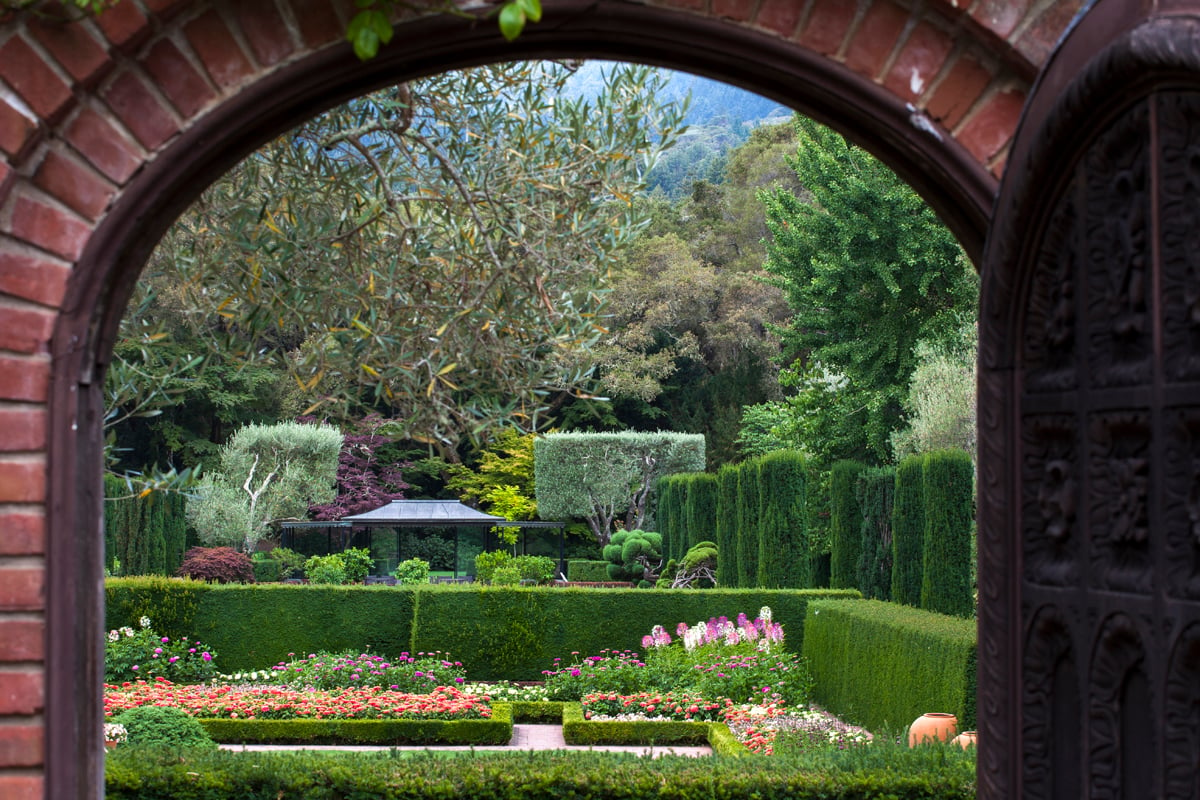
Lucy: Yeah. The focal point of the walled garden was the garden house, not the larger main house, and so the scale shifted. That’s what’s so remarkable about Filoli, these changes in scale and the importance of controlling the size of the plants.
But mostly the gardeners were dealing with basic plant preservation, keeping the plants alive, watering by hand and so forth. We had deer problems. We had water problems.
Molly: You definitely had water problems.
Lucy: We had water fights.
Dean would be fighting with Ron who would be fighting with … You know, the water pressure was so low everyone would be throwing stuff at each other. I made up this whole schedule. “Okay, Ron is going to water here, and Jim will water there.”
It was terrible. You know the whole supply for the water system was a deteriorating three-inch galvanized line that came up from Crystal Springs Reservoir—we had leaks all the time.
Molly: I was there when they actually put in the irrigation system, so that wasn’t until 1990.
Lucy: Right. We lived with the old system until then. The head of maintenance would go and turn on the pump, which was attached to a telephone pole at the edge of Crystal Springs Reservoir so that by the time we came in in the morning, the 50,000-gallon tank was full and we had pressure. But when he got ill, I was the one that drove down into the watershed at 2 o’clock in the morning.
Molly: No kidding?
Lucy: No kidding—in the green and white truck. I’d turn that pump on and get the water going so that by the time the staff came in, there’d be water in that tank. So, there was a lot of stuff that we did behind the scenes because we had to. We knew there was no money. We knew we just had to take care of things and we managed to figure it out. It was great.
Molly: You were working with garden survival. Other people were looking at garden preservation more philosophically.
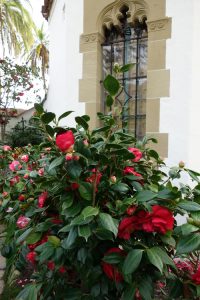
Lucy: Charles Birnbaum, founder of The Cultural Landscape Foundation, had a huge influence on our thinking about garden preservation. Terms like “character-defining features” actually helped us think in different ways and realize the important difference between restoration and preservation maintenance.
Molly: Renovating garden features can be shocking to people. At Casa del Herrero, there was an area where the camellias looked fine outdoors, but from inside of the house you could see that the plants were covering a beautiful window. So we cut the camellias down to stumps. People were convinced I was an axe murderer until the plants came back beautifully. Then everybody was like, “Oh, that window is lovely with the camellia underneath it.” After that we kept them to scale.
… Oh, and remember the arcade that was covered with ficus? I remember when you saw it the first time you visited me [at Casa del Herrero] you were pretty shocked at how overgrown it was.
Lucy: Oh, I do remember. You did a great job bringing that hidden architectural feature back to life again.

Molly: It was scary. I mean, ’cause people thought it was an iconic feature—the “topiary ficus”. But I was lucky because there were letters showing drawings of an arcade, with dimensions and everything. So I was able to say, “If you look underneath this ficus, that arcade actually exists.” But, that was a tough one. People were really resistant.
Lucy: Cutting the yews back at Filoli was a tough one, too. But you couldn’t get that view corridor for the yew allee without that step. The Garden Advisory Committee at Filoli was very supportive.
Molly: I remember learning traditional horticultural techniques at Filoli. It wasn’t just the garden, the buildings, and the plants that were traditional. The technology we used was also part of the preservation.
Lucy: Oh, absolutely.

Molly: You know I kind of missed it when Filoli’s greenhouses went from being hand-cranked vents to automatic. That was kind of a hard time.
I always thought doing that hands-on thing, reading the thermometer and looking at the rain gauge every morning, calibrated me. It got so that I could walk into a greenhouse and immediately know if it was a little cold, because I had been looking at the thermometer every morning.
Lucy: I think you’re absolutely right about that. If you start out your career learning those basics, even if you switch to a big mega operation, where everything is completely computerized, you’ll have a much better handle on what the plants need and appreciate.
Molly: Right. We weren’t using moisture meters. But we could look over the flats and see that there some plants were kind of grayish—they needed water.
Lucy: But it costs a lot of money to do it all manually; it adds up. We used to trim the grass around the pools with sheep shears.
Molly: I remember the reel mowers left such a beautiful cut on the lawns.
Lucy: We kept those going as long as we could. The first blower and weed eater was a huge deal. It was like “Oh god, I hate this.” All the horrible noise, but we could get the tennis court cleaned up before the public got there.
Preservation is hard work but it defined Filoli. You can’t let that priority slip or you lose the integrity and history of the garden.
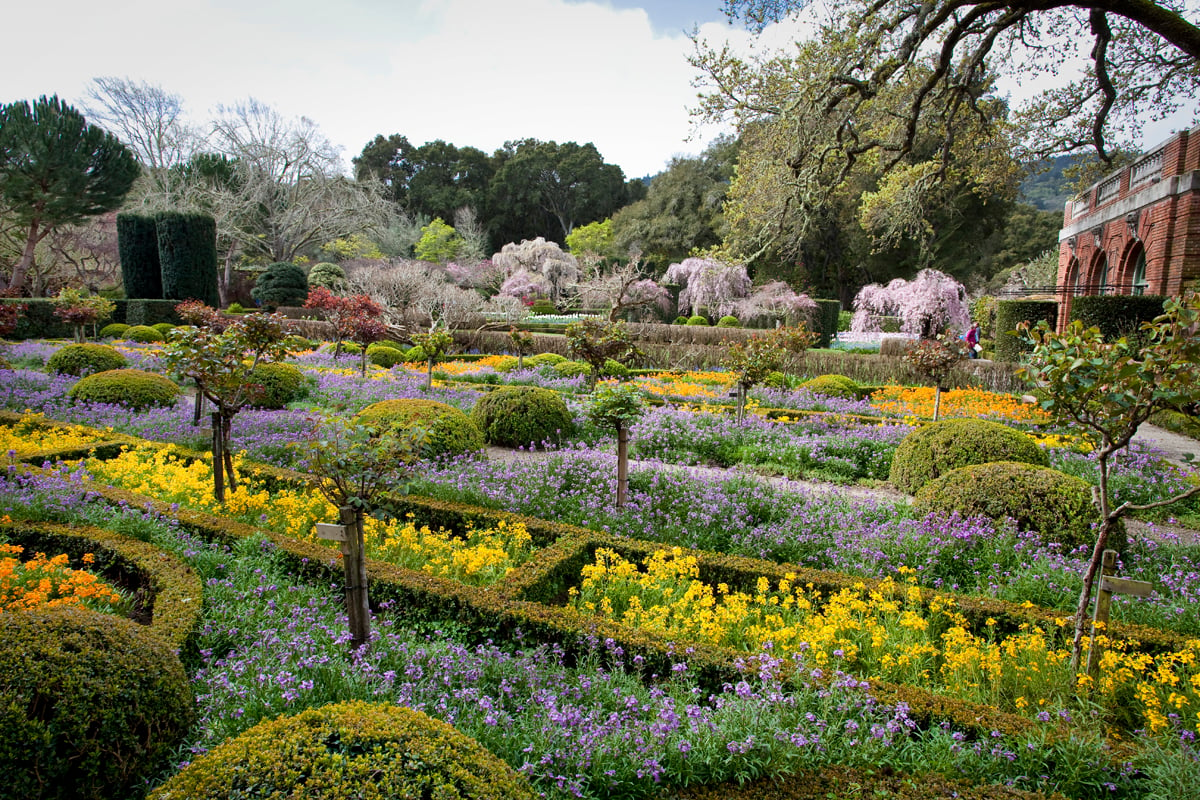
Molly: I completely agree.
So, what do you think of there not being very many people going into horticulture now? What do you think that’s going to mean to the gardens?
Lucy: I’m not giving up hope on the training programs. You know, I think Filoli did a great job with our intern program. That was the main reason Lurline Roth decided to give Filoli to the NTHP so that the garden could be used to train fine gardeners. Her thought was that the main house could be used to store fertilizer and equipment and house student interns.
Molly: No kidding. There are tons of horticulturists out there, myself included, who went through Filoli.
Lucy: And you’re going to go on and train your staff.
Molly: I have a great staff at MCBG.
Lucy: I have to have hope that some people will realize that their thumbs are green; that feeling and that relationship with plants is always going to be there. I’ve known many a gardener that never went through the fancy training yet they could tell when a plant was unhappy or happy. They had an artistic sense and knew how to prune, even though they never read the pruning books. It’s in our blood. So that gives me hope. We can’t help ourselves. We’re gonna be gardeners.
Molly: We can’t help it. Well, we could talk forever, but you’re off the hook for now.
Lucy: Oh, good. Now I can have a beer, right?
Molly: Yeah, yeah, me too. Jonathan makes the best beer, and we can finish our sandwiches.

Meticulously clipped plant forms and careful attention to scale compliment Filoli’s formal architecture and preserve historical axial view corridors. Photo: Saxon Holt/PhotoBotanic
Share:
Social Media
Garden Futurist Podcast
Most Popular
Videos
Topics
Related Posts

Low Maintenance Gardens – Better for Pollinators and People
Autumn 2022 “I come out every day. It’s therapy, my meditation.” Janet’s young garden transformed from overgrown, invasive plants to mostly natives. The dailiness of

Calochortophilia: A Californian’s Love Affair with a Genus
Summer 2022 I can chart the progression of my life by Calochortus. For the last two decades, at least. As a teenage girl growing up

Pacific Plant People: Carol Bornstein
Spring 2022 Public gardens play a key role in demonstrating naturalistic planting design, selecting native and adapted plants for habitat, and testing techniques for reducing

Add Year-Round Interest and Winter Blooms for Pollinators
Spring 2022 This article was created from an Interview by Merrill Jensen with Neil Bell in the Summer of 2021 for our Pacific Plant People









Responses